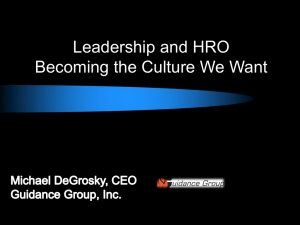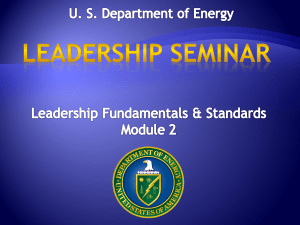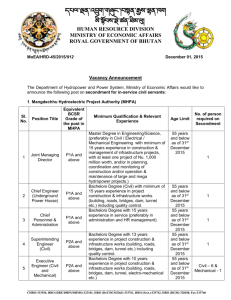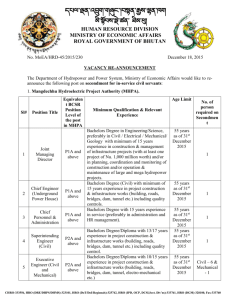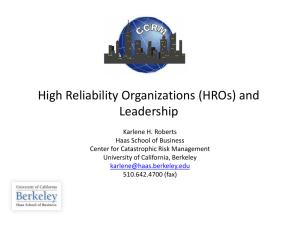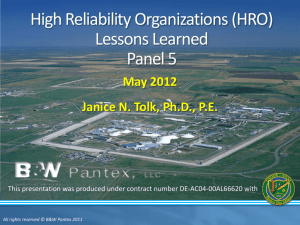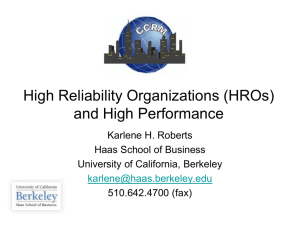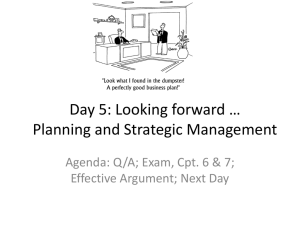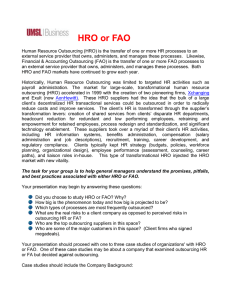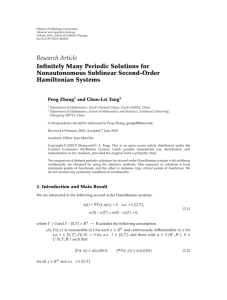First Line Supervisor Leadership Seminar
advertisement
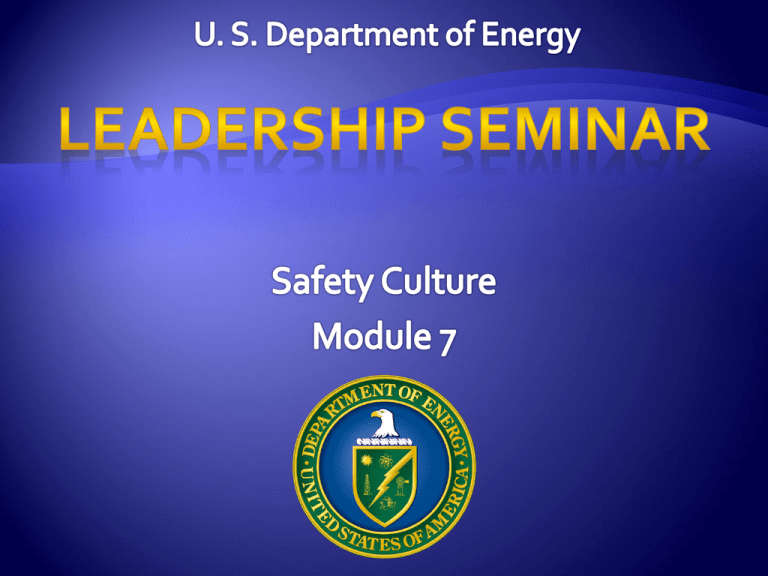
What is Culture to You? What Does Your Culture Look Like? How Do You Know? An Organization’s values and behaviors modeled by its leaders and internalized by its members, which serve to make safe performance of work the overriding priority to protect the workers, public, and the environment. HRO Practice #1 Manage the System, Not the Parts HRO Practice #4 Learn & Adapt as an Organization HRO Practice #2 Reduce Variability in HRO System HRO Practice #3 Foster a Strong Culture of Reliability To Sustain an HRO HRO Practice #3: Foster Strong Culture of Reliability HRO Goal: Align, tighten, and sustain spectrum of performance. Work-as-Imagined Work-as-Planned Work-as-Done Where you want to be The Work Environment I get docked for every mistake. I have more work than can be done in a day and they keep piling on more. The Culture I don’t report my mistakes. I cut corners. I want to get home to see my kids soccer games once in a while. I take the easiest path to every assignment. The procedures don’t work and no one will help get them changed. I don’t follow procedures. If I followed the system, nothing would get done. If I don’t produce, I get yelled at. Besides, nothing bad ever happens here. I work around the system when ever and where ever I can. The culture is not the problem, it is a symptom of the problem. Fix the problem. Address the organizational set-up factors. PERSPECTIVES FROM SCHEIN’S LEVELS OF CULTURE What You Do Behaviors What You Say You’re Going To Do What You Really Feel You Should Do Values and Beliefs Underlying Assumptions Weak safety culture when misaligned Schein, Organizational Culture and Leadership, 2004 PERSPECTIVES FROM SCHEIN’S LEVELS OF CULTURE What You Do What You Say You’re Going To Do What You Really Feel You Should Do Behaviors Values and Beliefs Underlying Assumptions Strong and Healthy safety culture when aligned Schein, Organizational Culture and Leadership, 2004 HRO Practice #1 Manage the System, Not the Parts HRO Practice #4 Learn & Adapt as an Organization HRO Practice #2 Reduce Variability in HRO System HRO Practice #3 Foster a Strong Culture of Reliability Background on “Why” A Safety Conscious Work Environment is being Implemented December 5, 2011 Memorandum signed by: – Secretary Steven Chu – Deputy Secretary Daniel B. Poneman Elements of Culture Organizational Culture Organizational Culture Safety Culture SCWE Safety Conscious Work Environment • A set of commonly shared beliefs, expectations, and values that influence and guide the thinking and behavior of organization members, and are reflected in how work is carried out. Safety Culture • Safety culture is an organization’s values and behaviors modeled by its leaders and internalized by its members, which serve to make safe performance of work the overriding priority to protect the workers, public, and the environment. Safety Conscious Work Environment • A Safety Conscious Work Environment (SCWE) is a work environment in which employees feel free to raise safety concerns to management (and/or regulator) without fear of retaliation. DOE G 450.4 -1C, Attachment 10 Attachment 10 identifies: Three Safety Culture Focus Areas and Associated Attributes that promote a shift from compliance towards excellence. They are covered on the next few slides. 1. Leadership 2. Employee/ Worker Engagement 3. Organizational Learning The intent of SCWE is to develop a “WILLING” and “ABLE” Environment in which employees can raise safety concerns. “ABLE” is established by having processes for people to communicate concerns, for management to receive them, review and then prioritize them, ensure problems resolved and the results communicated back to employees. “WILLING” is established by management behavior to receiving the feedback and learn from it. How do Leaders establish trust, questioning attitude and “willingness” for employees to raise concerns? 16 Why do People Not Report Safety Concerns? Chilled Effect – An environment in which employees are UNWILLING or UNABLE to raise safety concerns because the fear of retaliation. Leaders create and change culture Managers act within culture 21 Communication of Clear Behavioral Expectations Understand Expectations Training, Modeling, Support Practice New Behaviors Reinforcement, Consistency, Alignment Perform New Behaviors Form Habits of New Behaviors Desired Safety Culture Three Manageable Behaviors: “When we examine culture and leadership closely, we see that they are two sides of the same coin; neither can really be understood by itself . . . . . it can be argued that the only thing of real importance that leaders do is to create and manage culture; that the unique talent of leaders is their ability to understand and work culture; and that it is an ultimate act of leadership to destroy culture when it is viewed as dysfunctional.” Schein, Organizational Culture and Leadership, 2004 Identify 3-5 Specific Indicators/Trouble Signs that would indicate a potential weak Safety Culture Describe how you would address the issues within the DOE Environment. Chernobyl – 1986 Davis-Besse – 2002 Columbia – 2003 BP - 2010 Fukushima – 2011 • Unlock the power of differing opinions – Is someone assigned the task of challenging group assumptions and decisions? – Ask, “Why is this safe?” not “Why is this unsafe?” • Be respectful of people who raise well-intentioned objections – Even (especially) if they are later proven wrong • Choose to learn from minor events to avoid major events • Manage and model behaviors to change fundamentals • The Next Big Event is coming, but it will probably not look like the last one. • Nevertheless, if we want to achieve/sustain highly reliable operations, we need to use the current world events as an opportunity to refocus and reenergize our efforts to continuously improve safety. Multiple, overlapping, and mutually redundant safety management systems, grounded in ISM, High Reliability Attributes, and a Strong Safety Culture are a key to our continued success.. Record Daily Key Learnings: Group Consensus – Key Points Learned List on Flip Chart & Discuss Homework: Individual Action Plan Deliverable for Course Completion
